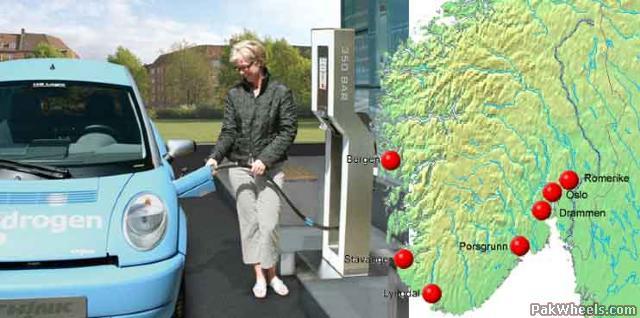FUEL CELL RALLY OPEN'S NORWAY'S HYDROGEN HIGHWAY
Norway opened a 560km "hydrogen highway" on Monday with more than a dozen hydrogen-powered cars rallying along a scenic route from its capital city Oslo to the North Sea oil hub of Stavanger.
Norwegian oil and gas producer StatoilHydro has built several hydrogen filling stations between the two places to cater for cars with fuel cells that generate electricity from a chemical reaction between hydrogen and oxygen or burn hydrogen in a combustion engine similar to those in petrol cars.
These zero-emission vehicles have short ranges but promising results and, in the longer-term, Statoil may link the road to a hydrogen autobahn in northern Germany,
Japan and California already have hydrogen highways.
"The torque in an electric car is fabulous," professional rally driver Henning Solberg told Reuters before taking off in the Viking Rally's No.1 car with Norway's Crown Prince Haakon.
"In acceleration, you could get as fast a car as you want with an electric engine," said Solberg, whose hydrogen-powered Ford Focus began the rally without the customary engine-revving and screeching tyres.
Touted as future alternatives to carbon dioxide-emitting petrol engines, the still-experimental hydrogen engines emit only clean water - though it takes a lot of energy to produce hydrogen.
Unlike electric motors, whose batteries take hours to recharge, the nearly silent hydrogen cars can be refuelled in a matter of minutes, much like a conventional car.
"We have to look for additional sources of fuel for the future and believe hydrogen is a good option,"said Ulf Hafseld, head of hydrogen business development at StatoilHydro, "especially as it has the characteristics of a zero-emission fuel and... you could produce hydrogen from many sources."
Some cars in the race can accelerate to 100km/h in four seconds, drivers boast, though the three-day rally is not about speed but reliability and efficiency, they agreed. !--div[code1]top.DisplayAds('SquareAV',19,751);[/code1]/div--
On the road in the rally's first stage to Drammen, west of Oslo, the talk in a specially modified Toyota Prius hydrogen hybrid, raced by team Statoil, was about fuel conservation.
"We have good downhills we can use for charging here," said driver Anne Marit Hansen, referring to a function that recharges the car's batteries by gently braking while coasting downhill.
Her Prius can travel 170-200 km before refuelling and fills up with about two kilograms of hydrogen gas. Its top speed is a little over 100km/h.
StatoilHydro sells hydrogen in Norway at around $6.28/kg, which it says is roughly equal in energy terms to the price of petrol. The company seeks to keep its hydrogen clean by using energy from Norway's vast hydropower-plants to split water into oxygen and hydrogen.
Hydrogen can also be produced as an industrial by-product, or even from waste gases such as methane, but all these processes are energy-intensive which limits the attractiveness of hydrogen-powered cars from an environmental perspective.
"A rich country such as Norway should help test hydrogen and electric cars but I already know what I will be driving in 20 years," said Frederic Hauge, the founder of the Bellonna think-tank, getting into his Tesla, a sporty battery roadster.
Participants in the rally say such driving tests will help improve their vehicles and gradually reduce costs, although state subsidies remain vital for any larger-scale projects.
"Oil companies and industry produce a lot of hydrogen but it's a political issue whether we want to exploit this in the automotive industry," said Fiat researcher Paolo Delzanno, driving a hydrogen fuel cell-powered Fiat Panda. - Reuters
